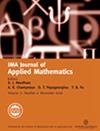分析两层学习的非精确超梯度
IF 1.4
4区 数学
Q2 MATHEMATICS, APPLIED
引用次数: 0
摘要
估计超参数是机器学习中一个长期存在的问题。我们考虑这样一种情况,即手头的任务被建模为优化问题的解决方案。在这种情况下,关于超参数的精确梯度无法计算,需要近似策略。我们引入了一个统一的计算超梯度的框架,该框架推广了基于隐函数定理和自动微分/反向传播的现有方法,表明这两种看似不同的方法实际上是紧密相连的。我们的框架非常灵活,允许用任何合适的方法以任何精度解决子问题。我们推导了所有方法的先验和可计算的后验误差范围,并在数值上表明我们的后验误差范围通常更准确。我们的数值结果还表明,令人惊讶的是,对于高效的双层优化,选择高梯度算法至少与选择低级解算器一样重要。本文章由计算机程序翻译,如有差异,请以英文原文为准。
Analyzing inexact hypergradients for bilevel learning
Estimating hyperparameters has been a long-standing problem in machine learning. We consider the case where the task at hand is modeled as the solution to an optimization problem. Here the exact gradient with respect to the hyperparameters cannot be feasibly computed and approximate strategies are required. We introduce a unified framework for computing hypergradients that generalizes existing methods based on the implicit function theorem and automatic differentiation/backpropagation, showing that these two seemingly disparate approaches are actually tightly connected. Our framework is extremely flexible, allowing its subproblems to be solved with any suitable method, to any degree of accuracy. We derive a priori and computable a posteriori error bounds for all our methods, and numerically show that our a posteriori bounds are usually more accurate. Our numerical results also show that, surprisingly, for efficient bilevel optimization, the choice of hypergradient algorithm is at least as important as the choice of lower-level solver.
求助全文
通过发布文献求助,成功后即可免费获取论文全文。
去求助
来源期刊
CiteScore
2.30
自引率
8.30%
发文量
32
审稿时长
24 months
期刊介绍:
The IMA Journal of Applied Mathematics is a direct successor of the Journal of the Institute of Mathematics and its Applications which was started in 1965. It is an interdisciplinary journal that publishes research on mathematics arising in the physical sciences and engineering as well as suitable articles in the life sciences, social sciences, and finance. Submissions should address interesting and challenging mathematical problems arising in applications. A good balance between the development of the application(s) and the analysis is expected. Papers that either use established methods to address solved problems or that present analysis in the absence of applications will not be considered.
The journal welcomes submissions in many research areas. Examples are: continuum mechanics materials science and elasticity, including boundary layer theory, combustion, complex flows and soft matter, electrohydrodynamics and magnetohydrodynamics, geophysical flows, granular flows, interfacial and free surface flows, vortex dynamics; elasticity theory; linear and nonlinear wave propagation, nonlinear optics and photonics; inverse problems; applied dynamical systems and nonlinear systems; mathematical physics; stochastic differential equations and stochastic dynamics; network science; industrial applications.

 求助内容:
求助内容: 应助结果提醒方式:
应助结果提醒方式:


